
Musical Soundalike of the Day, 4/29/2024
Something I’m trying since I’ve been having trouble keeping up in this blog, first a piece of music that sounds like a cross between previously-written pieces.
+
=
Let me know if the videos don’t work.

Something I’m trying since I’ve been having trouble keeping up in this blog, first a piece of music that sounds like a cross between previously-written pieces.
Let me know if the videos don’t work.

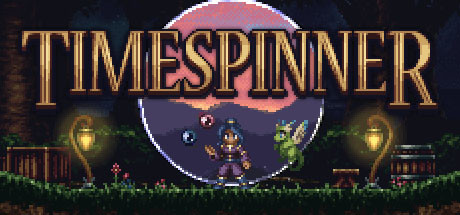
The year 2011 saw the founding of the videogame developer and publisher Chucklefish Limited in London, specializing in producing retro-styled games. Among their publications, developed by Lunar Ray Games, was the Metroidvania Timespinner, taking heavy inspiration from Konami’s Castlevania: Symphony of the Night and financed through the crowdfunding platform Kickstarter in June 2014. It was initially to be released in November 2015. However, the project’s scope led to delays to September 2018, initially on computer and PlayStation-based media, but it would expand to the Nintendo Switch and Xbox One.
As the game’s moniker implies, Timespinner’s narrative focuses on time travel, with protagonist Lunais, a Time Messenger, needing to traverse the present and the past to defeat the evil Lachiem Empire responsible for the death of her parents. The story has a few derivative elements and a point where I had to reference the internet to find out how to advance. However, the way the game tells it is surprisingly effective and never feels forced down the player’s throat, as with most top-tier titles. Many documents add nicely to the game’s background, with a slight hint of LGBTQ+ themes and multiple endings that add some lasting appeal.
Akin to the godfather of the Metroidvania genre, Timespinner features 2-D side-scrolling gameplay. Luna can equip a Main Orb and a Sub Orb, between which she alternates when attacking; a Spell Necklace that allows her to charge and execute magic; and a Passive Ring that allows for continuous skills, such as a pair of blades swirling about her and attacking foes. She also eventually accesses Familiars, who do their own thing and attack enemies, leveling occasionally. Killing enemies may drop items, some of which are necessary to complete sidequests, with Lunais herself occasionally leveling as well, getting money from both defeated foes and breaking light sources.
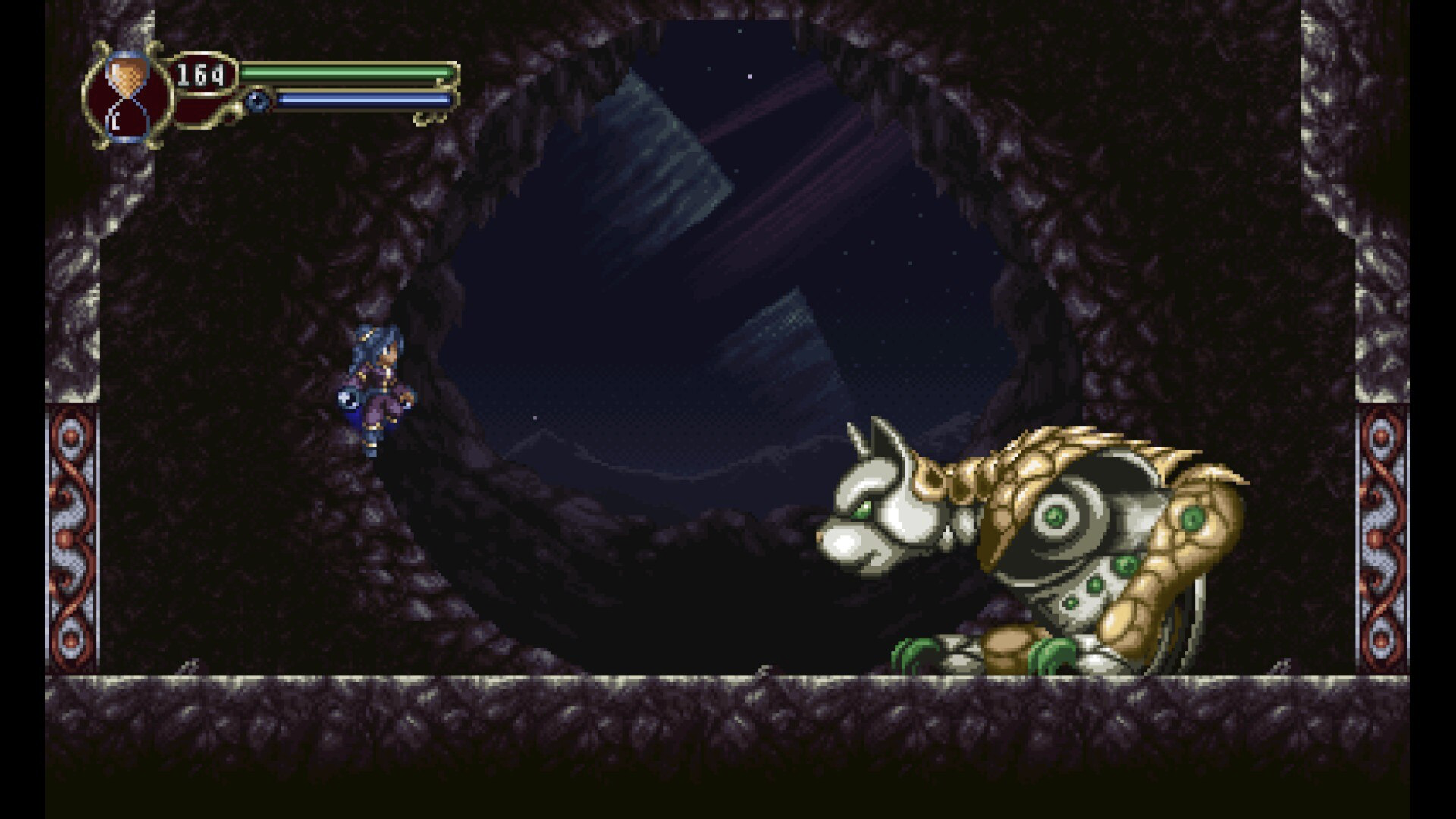
Throughout the past and present, Lunais can also find items that permanently increase her health, aura, and sand, the last of which she can use to freeze time temporarily, often necessary to use enemies as platforms to reach higher areas. Lunais can further equip headgear, a piece of armor, and two accessories; she can also purchase various items from shops. She may further find items that can level her orbs, with repeated use doing the same. The game mechanics are virtually flawless, aside from knockback endemic to most Metroidvanias (which can lead to situations like being forced to different chambers), with occasional bosses impeding Lunais’ progress, the Dream Mode difficulty allowing her to avoid death and fully heal when she reaches zero health.
Control also serves the game well, with easily navigable menus, enjoyable exploration, helpful in-game maps where players can place markers of different colors, and pleasant platforming. While one could argue that, in difficulties above Dream Mode, the player can waste progress if killed far from restorative save points, a buyable item allows Lunais to teleport to the last safe zone, which is helpful when she’s close to death. However, there are issues like the lack of a suspend save (which I could have sworn was in other game versions I played) and poor direction (in which case I had to reference the internet). Regardless, Timespinner interfaces with players like a dream.
Jeff Ball provides a soundtrack stylistically like that of the Castlevania series, with good use of instruments such as the piano and harpsichord. Tracks like “Masquerade of Hedonists” sound like they came straight out of the iconic Konami series (and could easily pass as being written by Mozart), with other pieces like ”The Broken”, the first boss battle theme, evoking a similar feel. Some voice clips include Lunais’ grunting when attacking and occasional laughter. The sound effects are also good, and while there are some silent portions, namely most cutscenes, Timespinner is very much an aural delight.
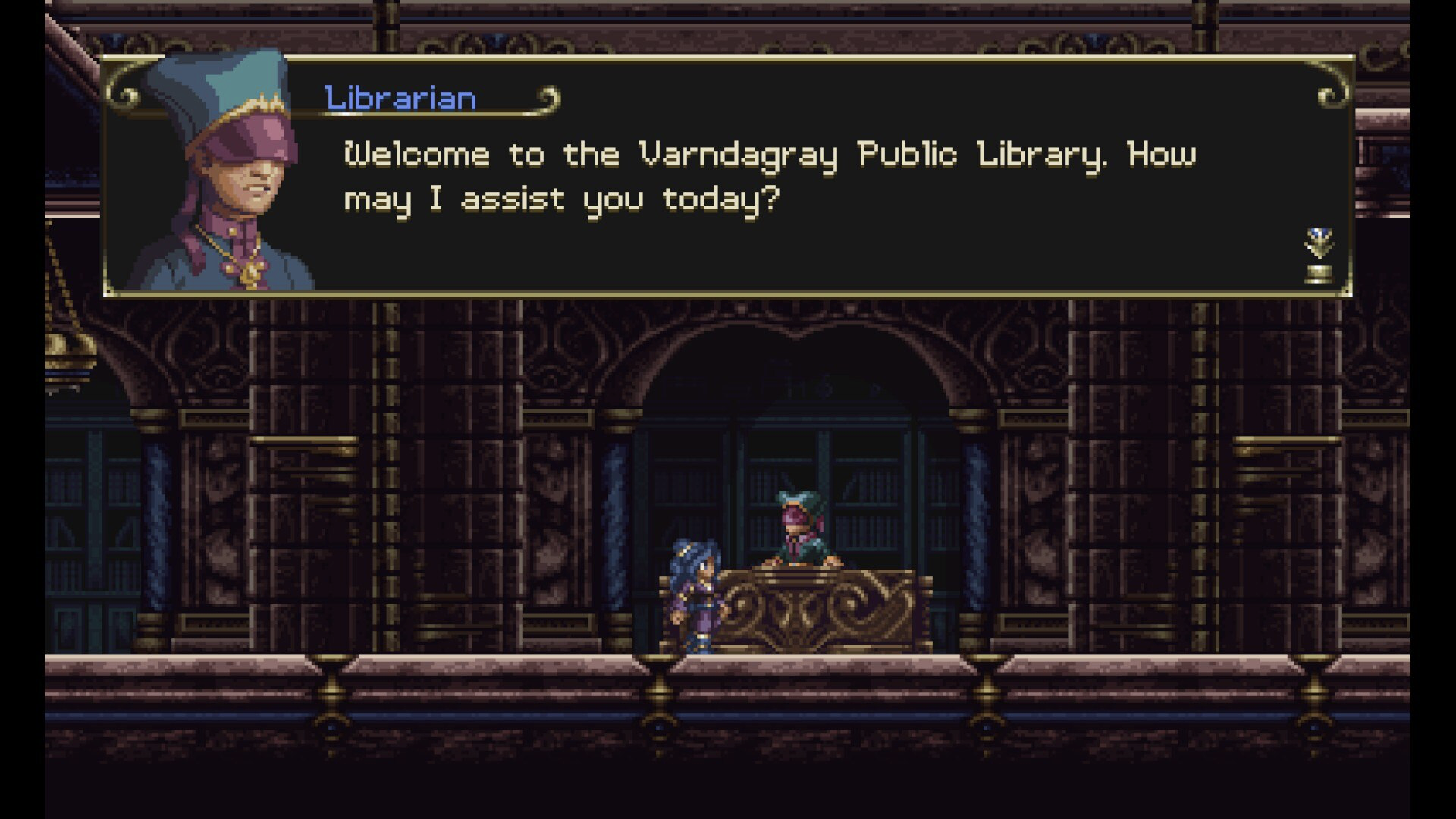
The visuals also evoke Timespinner’s Castlevania inspirations, with gorgeous pixel art, character portraits prominent during dialogues, enemy designs, colorful environments, and smooth animation. There are a few reskins in terms of foes, the sprites mostly don’t show emotion, and equipment doesn’t affect Lunais’ appearance, but otherwise, the game graphically excels.
Finally, finishing the core game can take as little as three hours. However, there is a plentiful lasting appeal in the form of a New Game+, multiple endings (many of which one can view within the same playthrough, and the ending credits become skippable after being viewed once), completely mapping every area, fully leveling Lunais, completing the game compendia, in-game Feats, Steam Achievements, and so forth, so absolute completion can naturally take far longer.
Overall, Timespinner is easily one of the high points of the Metroidvania gaming genre, given its superb gameplay, tight control, engaging narrative, excellent soundtrack, gorgeous graphics, and abundance of side content, surpassing others in terms of quality. While there are negligible flaws in aspects like control and the visuals, and one may argue that it lacks quantity, it quickly makes up for in terms of quality. The supplemental content will also appease those who habitually complain about short games. I enjoyed the various times I played through the game, and I very much look forward to its forthcoming sequel whenever it is eventually released, if ever.
This review is based on a single playthrough on Dream Mode of around eight hours on a Steam Deck of a digital copy purchased by the reviewer, with multiple endings viewed, and 7/37 Steam Achievements acquired.
| Score Breakdown | |
|---|---|
| The Good | The Bad |
| Superb Metroidvania mechanics. Excellent lore and narrative. Solid audiovisual presentation. Plenty of lasting appeal. | Typical Metroidvania knockback. Easy to get lost at times. Some derivative story elements. A lot of reskinned enemies. |
| The Bottom Line | |
| A crowning achievement among Metroidvanias. | |
| Platform | Steam |
| Game Mechanics | 9.5/10 |
| Control | 9.0/10 |
| Story | 9.0/10 |
| Aurals | 9.5/10 |
| Visuals | 8.5/10 |
| Lasting Appeal | 10/10 |
| Difficulty | Adjustable |
| Playtime | 3-48+ Hours |
| Overall: 9.5/10 | |


Did some more exploration and quests, but got lost and had to reference the internet since I forgot to check a skeleton in an area I had visited to get a keycard necessary to advance.
When playing my Steam Deck portably, I can take screenshots just fine, but for some reason still not with my controller on TV…


Continuing to plow along. Beat some bosses. Explored some previous areas I was unable to access. Finished a few quests. Love how the game tracks if enemies have drops you haven’t gotten yet.
Asked about my screenshot-taking issues with my Steam Deck, but haven’t gotten a response yet.


I’m playing this on Steam now (and played it two times before, on PlayStation 4 and Vita) since there’s a sequel forthcoming, and I have really fond memories of the game, in my opinion one of the best Western Metroidvanias. Also one of the best Western RPG soundtracks of all time, and Jeff Ball really does a nice job mimicing the style of JRPG music (with the Castlevania series seeming to have been his biggeest inspiration).
Here are some screens from my first hour with the game.
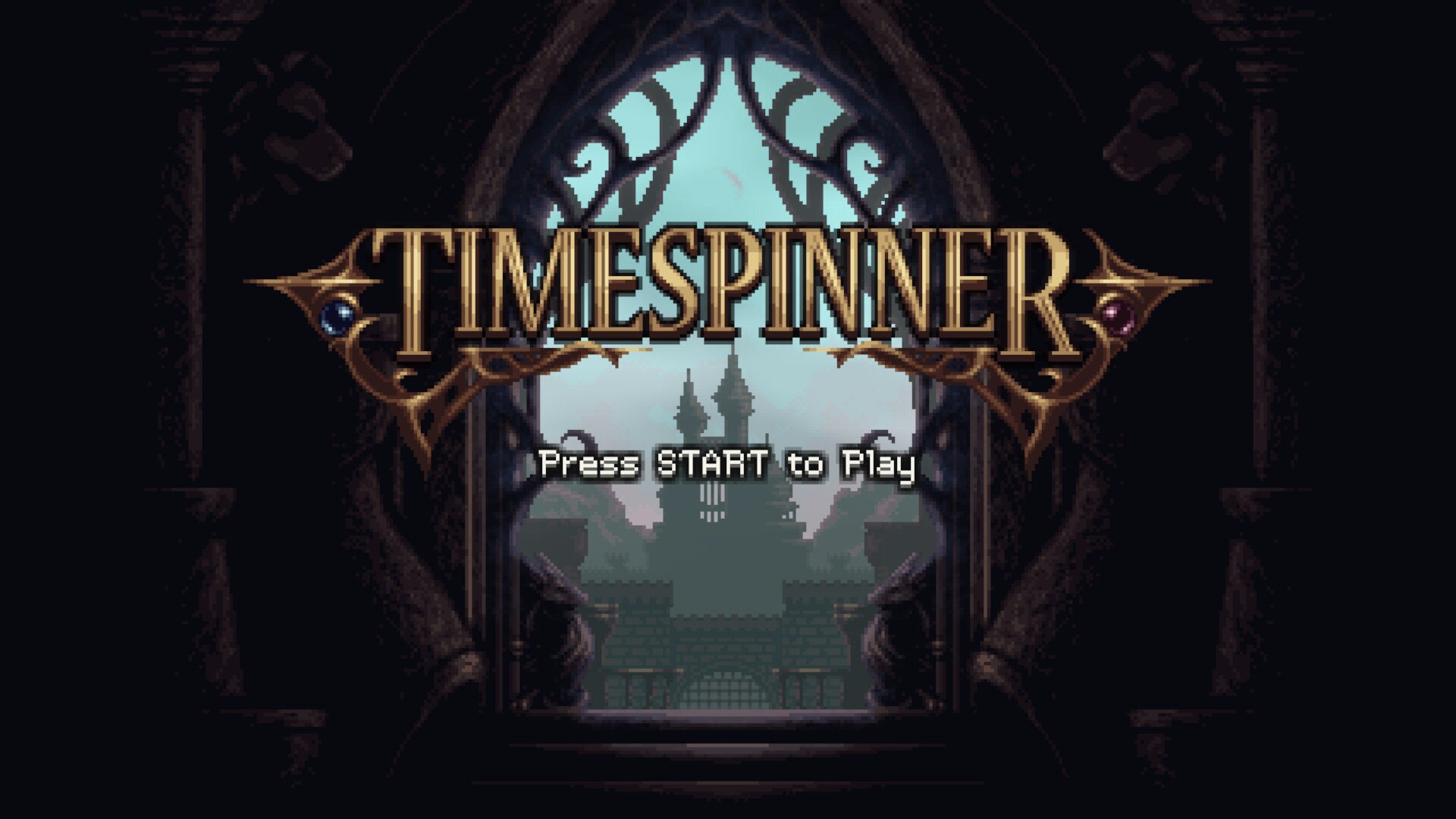




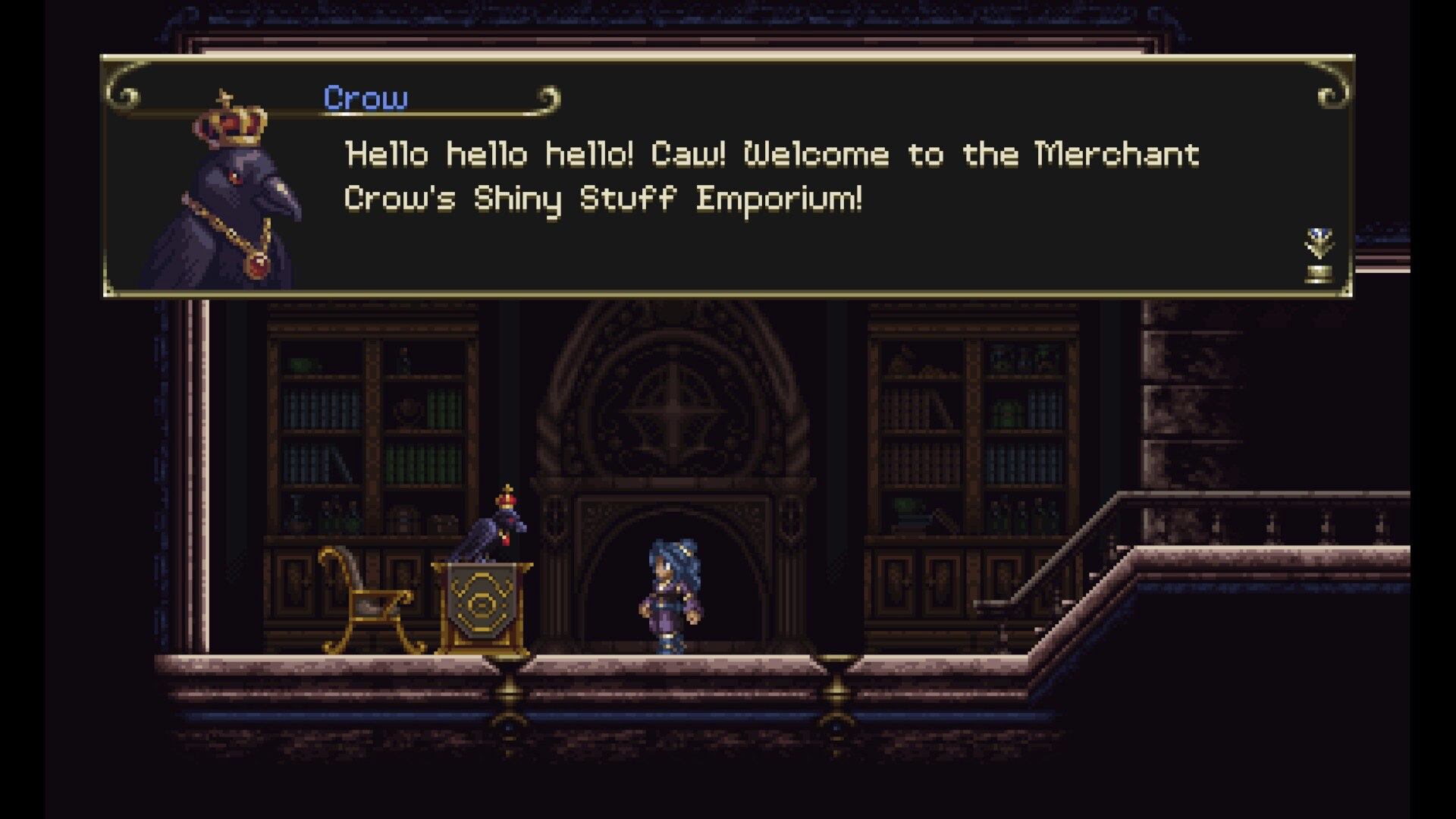
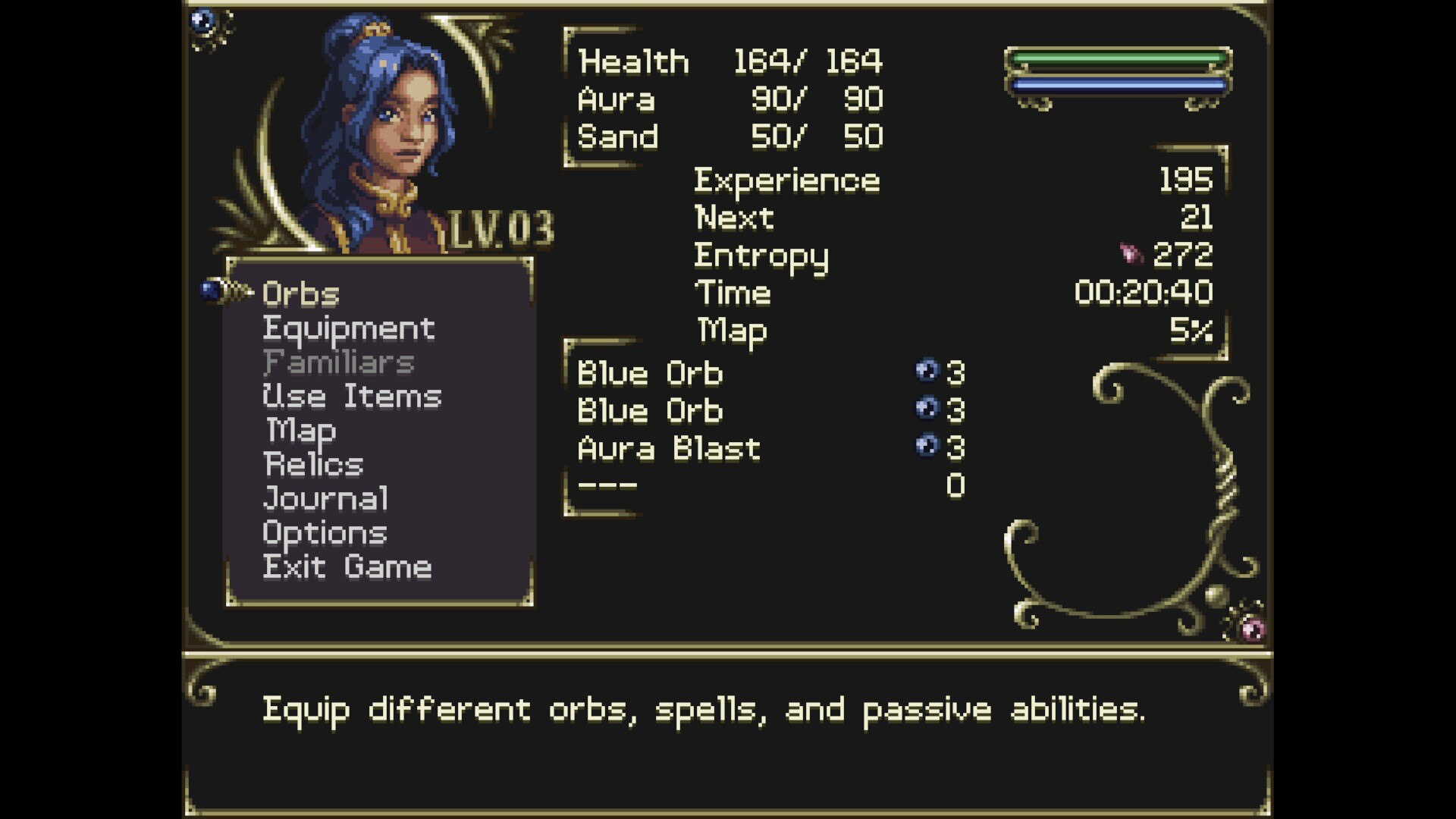
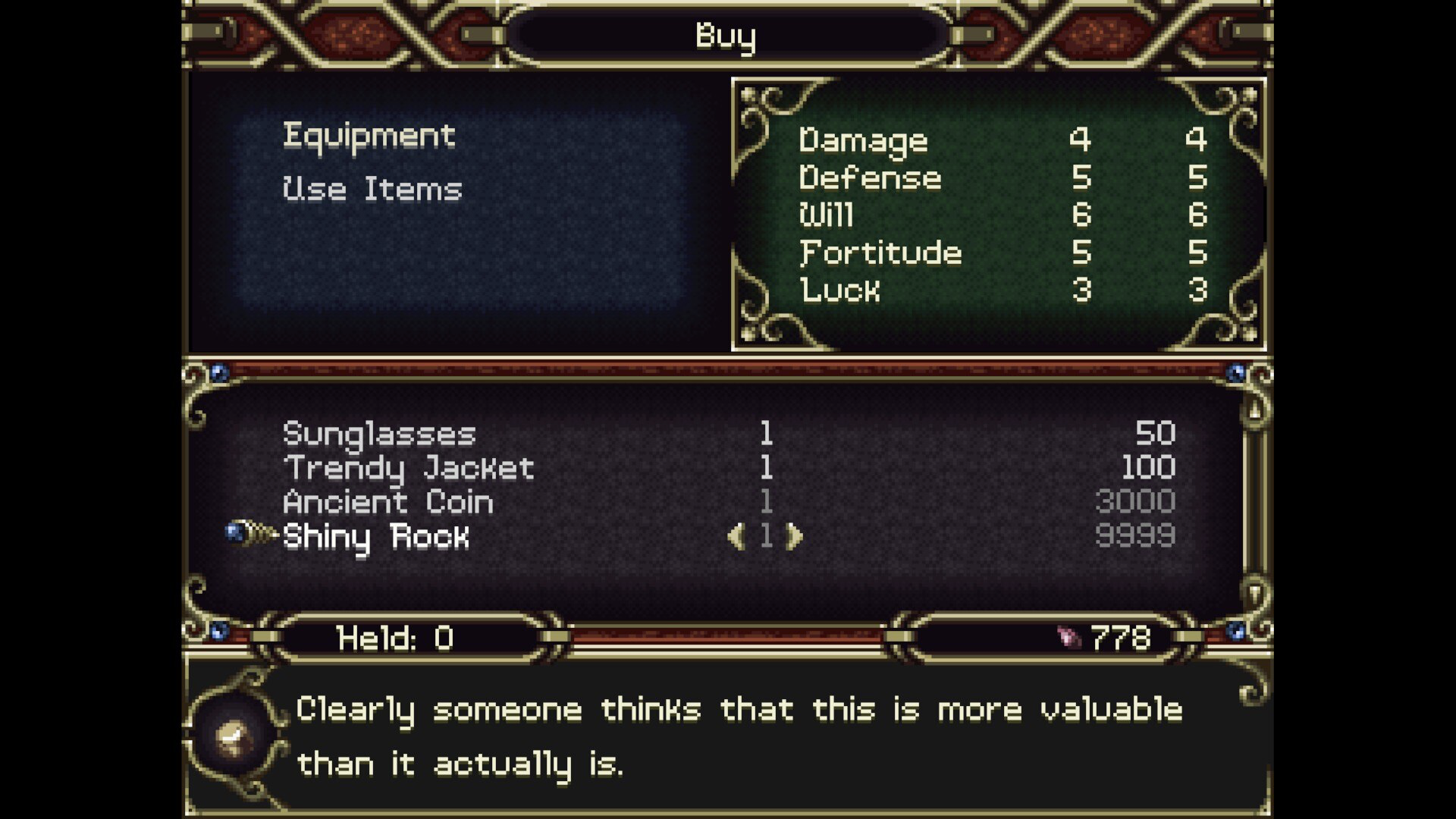
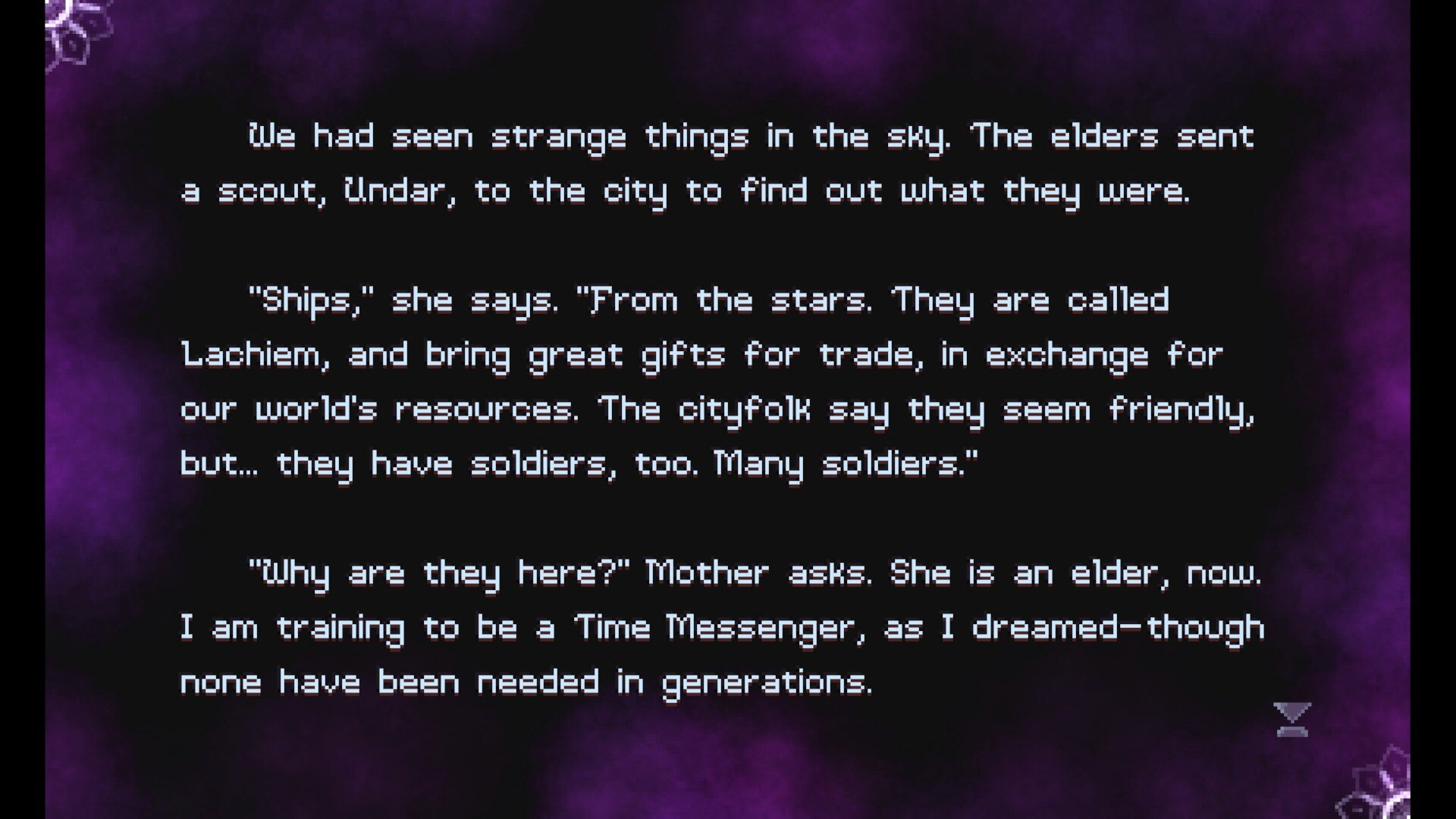

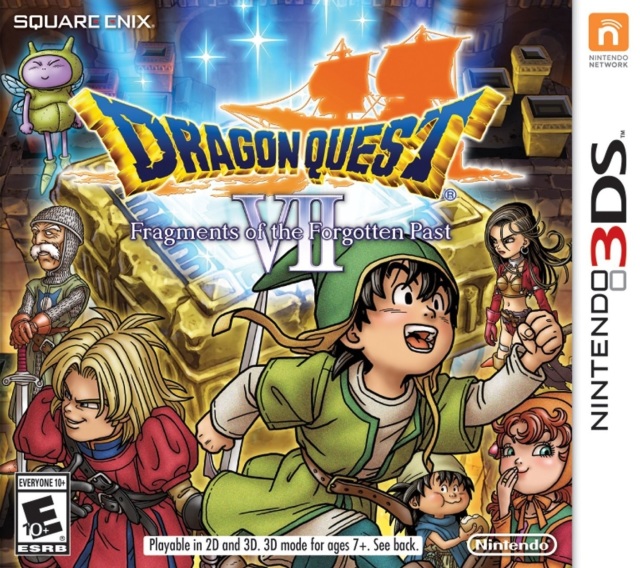
One of the final RPGs I played for the Sony PlayStation was Enix’s Dragon Warrior VII, titled Dragon Quest VII: Warriors of Eden in Japan, which was the first entry of the series I played on a console since the original Dragon Warrior on the Nintendo Entertainment System. Throughout the 2000s, the franchise would undergo a translational renaissance in the West, culminating in retaining the Dragon Quest name outside Japan. However, success in the Anglophone world would vary drastically. Thus, the seventh Dragon Quest remake for the Nintendo 3DS seemed doomed to remain in Japan when released in the next decade. Mercifully, it would be rescued and localized as Dragon Quest VII: Fragments of the Forgotten Past.
The rerelease opens on Estard, the only island in the world, with the protagonist, the son of a fisherman and his wife, working with Prince Kiefer, the kingdom’s reluctant heir, to delve into the world’s mysteries, which may lead to clues as to why their isle is all alone in the first place. The town mayor’s daughter, Maribel, joins them, with the party getting the help of individuals like the scholar Dermot the Hermit to investigate the Shrine of Mysteries, populated with pedestals that can contain the subtitular fragments scattered across Estard, which hold the key to their world’s “forgotten past.”
The scenarios the hero and his allies encounter throughout the game are endearing, developed well, have backstories, and explain why Estard seems all alone. Some texts from bookshelves add background and philosophy, with many relatable themes abounding, like unsupportive parents, rewriting history, burying inconvenient historical facts, etc. While the periods and connections between past and present scenarios aren’t always explicit, they are still intriguing. Drawbacks include glacial pacing, methodical story structure, predictable and derivative plot points, and vague narrative direction. Regardless, the narrative is an excellent draw to the game.

The localization, characteristic of previous series entries translated into English, breathes life into the dialogue, with the PlayStation version’s script having amounted to more than ten thousand pages, which could have explained the long translation period. Regional dialects return in full force, representing linguistic groups like the English (Renaissance and contemporary), Scottish, British, Cockney, French, Germans, Russians, and more. Clever naming conventions also abound, like renaming Prince Kiefer’s father King Donald in honor of the Sutherlands, numerous pun-based identities for individuals and enemies that include Cardinal Sin, Dermot the Hermit, the forky pig, the tongue fu fighter, etc.
However, the translation retains countless irritating conventions of Japanese RPG dialogue, including a chronic overuse of exclamation points and ellipses, spelled-out laughter (like “ha, ha, ha,” which today only sounds natural if done sarcastically), other onomatopoeia rendered in English (like sleepers saying “Ah-phew! Ah-phew!”), and so forth. Occasional awkward dialogue abounds as well, which encompasses the franchise’s staple encounter quote “But the enemies are too stunned to move!”, and a few punctuation marks are misplaced. There’s also maybe one inconsistent spelling of a character’s name (Autonymous instead of Autonymus), but the localization overall shines.
As a testament to the glacial pacing, players don’t encounter their first enemies until over an hour into the narrative. However, the tempo of the game mechanics beats in the opposite direction. At first, they seem like standard Dragon Quest: the player inputs commands among up to four characters, like attacks with equipped weapons, defense to reduce damage, MP-consuming magic, or various skills that may or may not require MP. The standard rules of traditional turn-based Japanese RPG combat exist, with characters and the enemy, after the players input their party’s orders, exchanging commands in an order allegedly depending upon agility, but this can be random and lead to occasional incidents of things like healing allies low on HP coming too late.
The player can attempt escape from combat, but as with 99.99% of JRPGs (except maybe Chrono Cross), this doesn’t work all the time. Other features include AI options for all characters except the protagonist (alongside a manual selection of orders), which players can set for individual allies or the entire party. These include not using MP when selecting commands, going medieval against enemies, focusing on keeping HP high, and emphasizing stat-boosting abilities and defense. While AI, of course, can often be artificially incompetent, I found this handy (especially “Don’t Use Magic,” since dozens of excellent free skills come later in the game), and methinks it shaved a few hours off my total playtime than if I had always selected skills myself.
Victory results in all characters still alive acquiring experience for occasional leveling, money, and occasional items. I should add that the remake ditches random encounters (except in one late-game dungeon, the Multipleximus Maximus) in favor of visible enemies, who charge the player’s party when their levels are lower than or equal to theirs and run away otherwise. One spell, Holy Protection, can temporarily make enemies on fields and in dungeons other than those higher in level disappear, nullifying the possibility of accidentally bumping into weaker foes. The difficulty for the first part of the game was fair for me, and I often needed to use consumable healing items in a few tough boss battles.
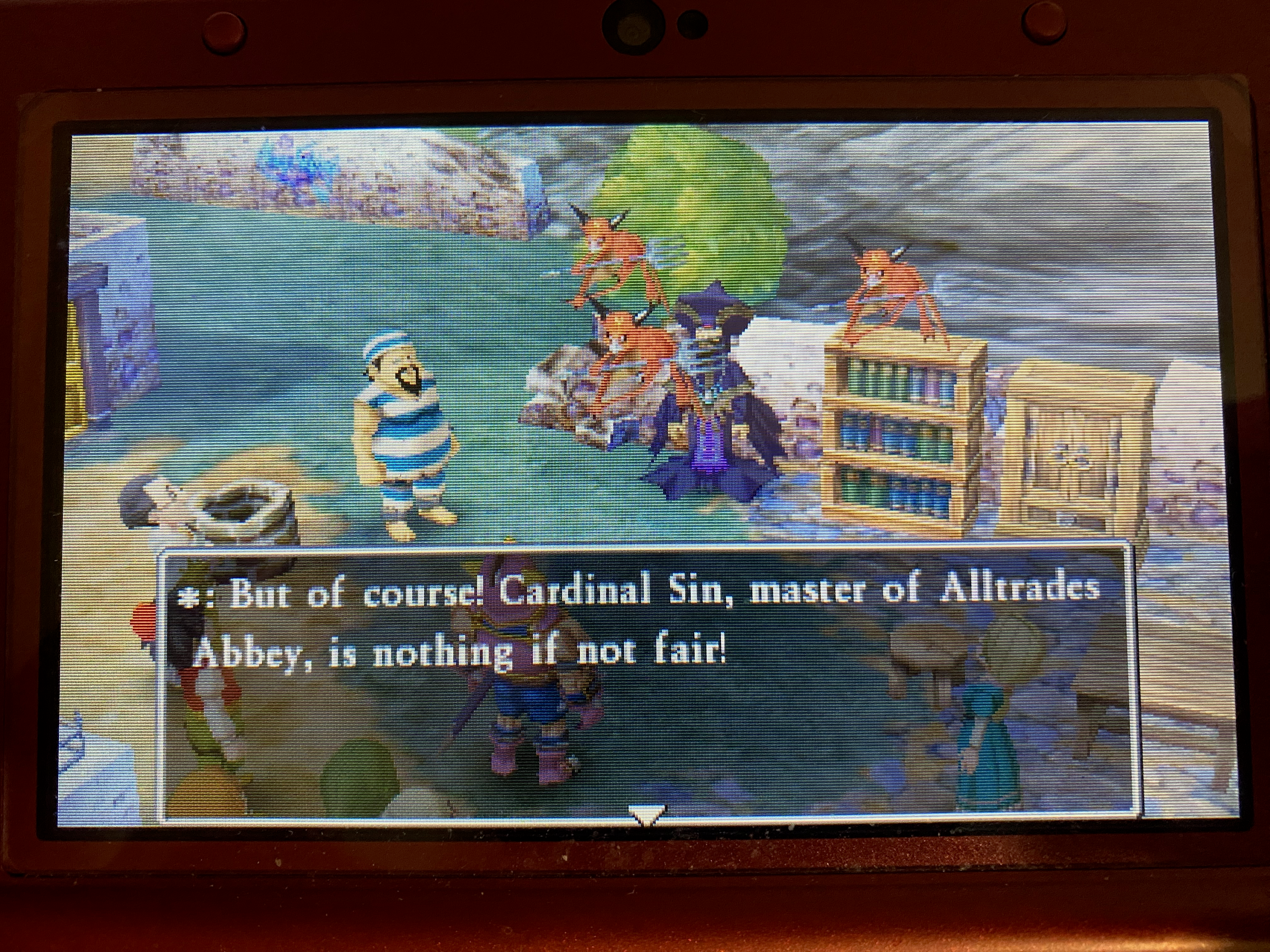
When the player unlocks Alltrades Abbey (after Kiefer leaves your party permanently, so don’t waste stat-increasing seeds on him or worry about constantly upgrading his equipment), the fun truly begins. Then, players access an engrossing class system, with their party able to select from many base vocations; mastery of these unlocks those of higher tiers. Every class increases and decreases all a character’s stats by a certain amount. Fortunately, players need not keep tons of spare equipment available for job changes like Final Fantasy V. As in Dragon Warrior VII, characters acquire experience for their vocation after triumphing in an enemy encounter, but only if the foes’ levels are on par with or higher than theirs.
One improvement over the PlayStation version is that class levels rise quicker, but at the same time, characters can now only access abilities in intermediate and advanced classes if in the former or the latter if the middle-tier classes are prerequisites for those upper-tier. Monster classes from the original return (their respective hearts acquired from treasure chests or battle) and allow them to transform into these adversarial vocations to learn their skills. Unlike Dragon Warrior VII, enemy vocations are no longer divided into a hierarchy, with all skills learned from them remaining with the allies who learn them regardless of their current job.
Returning to the matter of free skills, which characters will learn frequently, many can be incredibly useful, like Hatchet Man, which has a 50/50 chance of dealing unblockable critical damage to enemies and can be handy at making mincemeat (or mincegoo) of metallic slime foes that run away quickly but reward ludicrous experience when killed. However, this can be a double-edged sword since it can consequentially level characters to the point where they don’t advance in their classes (but in most late-game areas, enemies will reward class experience regardless of strength or weakness).
To sum up, the game mechanics work surprisingly well, especially with the pacing of combat contradicting that of the narrative. I could end most standard battles on the highest speed setting within a round or two without half a minute passing. Furthermore, with character class paths planned carefully, I blazed through the final boss fight without dying. However, many issues from prior series entries recur, like the inability to target specific enemies in groups, the randomization, no telling of when beneficial spells (except Oomph) expire, and the AI not being foolproof. Late-game, furthermore, when the player has five party members, the extra can’t come along, which is a step down from previous installments where one could have everyone and switch them in and out of battle on the fly from reserve.
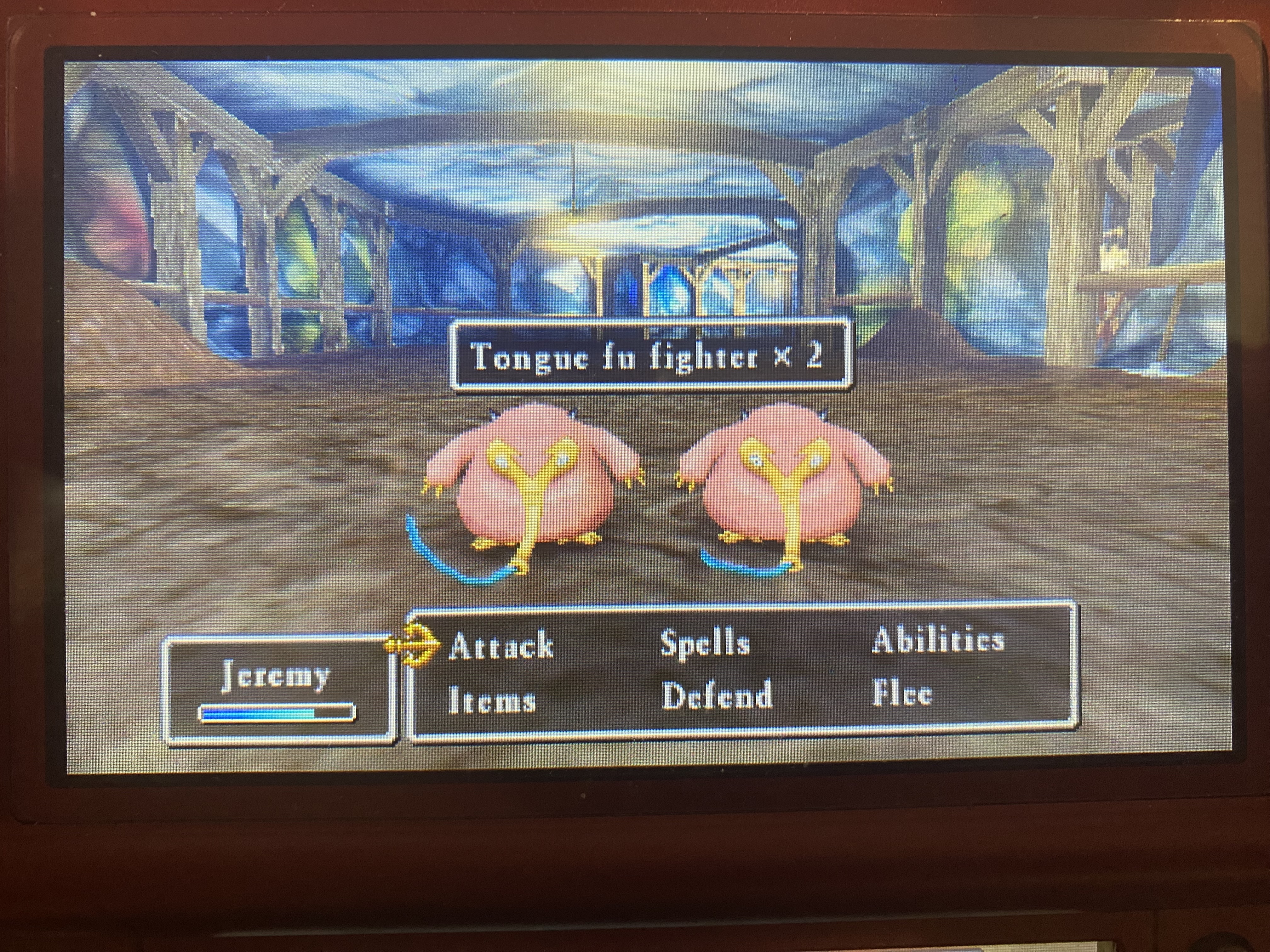
Control has rarely been a strong suit in the Dragon Quest series, and the seventh entry’s remake continues that trend. Endless dialogue and confirmations when performing simple tasks like shopping and saving your game? Check. Frequent vague direction on advancing the main storyline, even when talking to everyone? Check. Needing constantly to reference the internet regarding said poor direction and other things like hidden secrets and puzzles? Check. However, conveniences like instant teleportation among visited towns and exiting dungeons return, though these have issues, with the former only working in the present and the latter not always readily available. Furthermore, when acquiring the second nautical ship late-game, I couldn’t figure out how to get off the thing without using Zoom to a town, and the in-game clock was slow.
Even so, the fragment finder, which indicates whenever the subtitular fragments are nearby, is the best improvement over the PlayStation version. The fairy at the Shrine of Mysteries also often clues players about the location of the next one necessary to access a new area in the past. However, this did fail me at one point later in the game since I had to talk to a nonplayer character to get the detector to work in a respective area. Other improvements include maps for towns and dungeons (but in their case, players can’t swap among maps within and without floors to see how they’re connected) and an always-convenient suspend save in case reality calls. Overall, the interaction aspect doesn’t fail miserably but could have been far better.
The late Koichi Sugiyama’s soundtrack, gloriously orchestrated in the remake, excels as always, with the return of the standard series overture, staple franchise tracks such as the save menu theme, and others that fit the various moods and settings. However, many moments are without music, and the franchise’s dated sound effects return in full force.
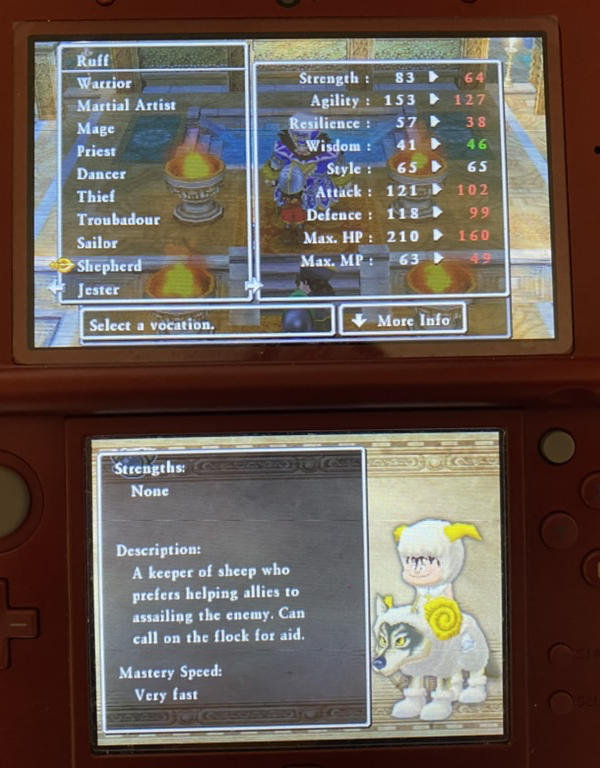
The remake’s visuals are far better than those in Dragon Warrior VII, fully rendered in three dimensions and taking advantage of the Nintendo 3DS’s glasses-free 3-D capabilities. The environments have vibrant hues (but frequent blurry and pixilated textures, characteristic of most three-dimensional graphics), and the illumination effects are superb. The character models fit the late Akira Toriyama’s character designs, including lip animations (but facial expressions mostly remain happy), and different vocations yield alternate costumes for the player’s party. However, Toriyama’s standard enemy reskins commonly recur, horrible collision detection abounds, and environmental elements frequently, abruptly, and unnaturally appear during overworld navigation. Regardless, the 3DS version’s graphics are a sight to behold.
Finally, finishing the main quest can take players as little as sixty hours (my final playtime clocked somewhere over eighty), with sidequests galore like countless subplots, completing the monster compendium, and two postgame dungeons, which can pad playtime further. However, the game excessively overstays its welcome, with other detriments to lasting appeal like fixed difficulty, minimal narrative variations, no New Game+, and the constant need to reference the internet to complete anything and everything.
With tight and enjoyable game mechanics, an intriguing narrative, and solid audiovisual presentation, Dragon Quest VII on the Nintendo 3DS is both an excellent remake and one of the far better entries of a series whose quality has ranged from okay to decent. However, issues like the need for foresight in character class path planning, retained dated series traditions, and glacial and vague narrative direction detain it from masterpiece status. Regardless, I enjoyed the time I spent with the game and wish others the same positive experience. Lamentably, events like the Nintendo 3DS eShop’s closure and the worldwide gaming industry’s apathy towards the preservation of video game history (enforced by American groups like the Entertainment Software Association) have made herculean the capacity to play it affordably and legally, but if it ever receives an enhanced port or secondary remake (provided they don’t screw things up), pick it up.
This review is based on a playthrough of a digital copy purchased and downloaded to the reviewer’s Nintendo 3DS to the standard ending, with none of the postgame content experienced.
| Score Breakdown | |
|---|---|
| The Good | The Bad |
| One of the best, if not the best, JRPG class systems. Engaging substories, with endearing localization. Excellent soundtrack. Visuals are a million times better than the PlayStation version’s. | Character class planning requires some foresight. Retains franchise’s dated traditions. Incredibly glacial narrative pacing and vague direction. Good luck finding it at a reasonable price. |
| The Bottom Line | |
| An excellent remake, but terrible narrative direction and overstaying its welcome prevent it from masterpiece status. | |
| Platform | Nintendo 3DS |
| Game Mechanics | 9.0/10 |
| Control | 6.5/10 |
| Story | 9.0/10 |
| Localization | 9.0/10 |
| Aurals | 9.5/10 |
| Visuals | 8.5/10 |
| Lasting Appeal | 6.0/10 |
| Difficulty | Easy to Moderate |
| Playtime | 60-120 Hours |
| Overall: 8.5/10 | |

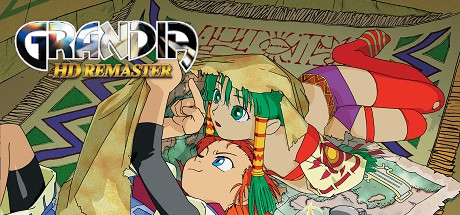
Once upon a time, Sony had emerged as a competitor in the video game market with its PlayStation console, originally intended to be a compact disc add-on for Nintendo’s Super NES before negotiations fell through. Sega had also released its Saturn console to provide competition for Sony’s system, receiving a decent catalog of exclusive games like the Game Arts-developed RPG Grandia. However, due to Sega executive Bernie Stolar’s prejudice against Japanese roleplaying games, Anglophone gamers were denied a translated version, Stolar having had similar policies when he headed Sony of America.

However, Grandia would be ported to the PlayStation and receive a full English translation, seeing release in 1999 two years after the Sega Saturn version. Critics and audiences would extol it as one of the greatest RPGs ever made, given its unique battle system, but it had its share of detractors critical of various technical issues, the sloppy translation, and the horrible English voicework that would go for decades unaddressed, after which the game received a remaster, along with its first sequel, to the Nintendo Switch and Windows. This rerelease provided a prime opportunity to rectify the various issues of the PlayStation version, but does it?
Grandia opens in the city of Parm with Justin, an aspiring adventurer, having a “duel” with his rival Gantz that involves finding faux legendary pieces of equipment scattered throughout town. Justin also has an enigmatic artifact from his absentee father, the Spirit Stone. Thus, he searches the nearby ruins to gather clues, with the Garlyle Forces, led by General Baal and his son Colonel Mullen, expressing similar interest. The result is a grand adventure by Justin as he embarks on a quest to discover the mysteries of the ancient and hilariously named Angelou civilization with the help of others while dealing with the adversarial military.
The quality of the narrative is inconsistent, with the initial rivalry with Gantz being asinine, along with countless fetch quests that contribute little to the central storyline, not to mention countless tried tropes like an absentee father and an ancient civilization, as well as pitiful attempts at humor and glacial plot pacing. However, the game backstory is decent for Angelou and the inhabited world. Many plot beats work well also, like the different and sometimes animal races, a few decent twists, serviceable attempts at comic relief like the three female sergeants Justin and his party repeatedly encounter, and the satisfying ending. Regardless, the story is average at best.
While the Grandia series now falls under Square-Enix ownership, publisher GungHo sadly made no effort to update the sordid translation by Sony America that plagued the PlayStation version, intact and reused in the remaster. Terrible names such as Gantz and Tentz, compressed item names in the game menus, spelled-out laughter, crying, and grunting, overuse of ellipses and exclamation points, unnatural battle dialogue, lousy spell names like “WOW!”, poor writing like “I, (insert name here),” and so forth, heavily abound. The text is legible, and the translation makes some attempts at dialects for specific regions and races. However, the game localization is one of many areas where the HD remaster was a wasted opportunity.
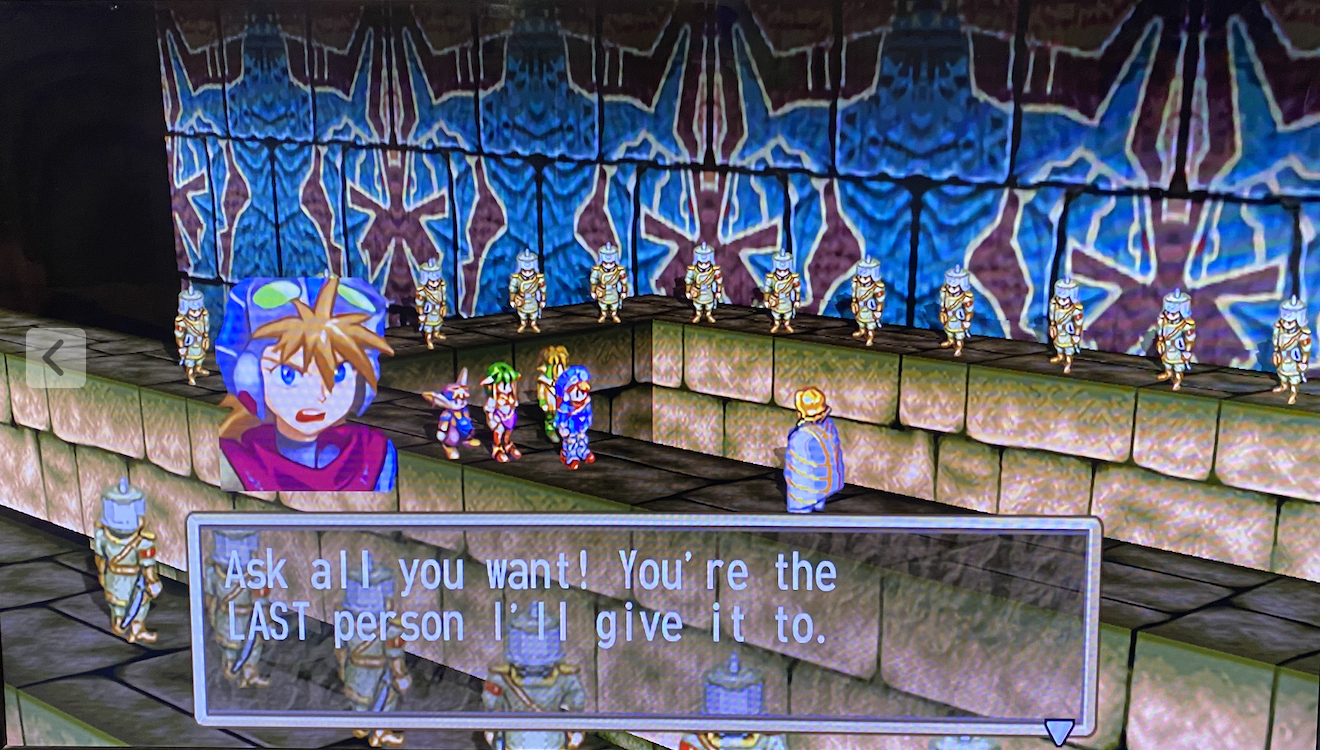
The Game Arts franchise has received near-universal praise for its game mechanics, which remain unchanged from the original Saturn and PlayStation versions of Grandia. On fields connecting towns and in dungeons, visible enemies abound, with contact resulting in the game taking players to a separate screen for combat. However, rather than take cues from the visible encounter systems of previous RPGs like EarthBoundand Chrono Trigger, the inaugural entry instead has all foes that Justin and company draw near charge his party, regardless of how powerful they are, with a few enemies having cheap movement patterns such as disappearing from the field and reappearing somewhere else.
How contact between Justin’s party and the visible enemy occurs determines how combat begins. Justin contacting the foe when it hasn’t turned red to indicate alertness results in his party having the initiative, contact by the enemy on one of Justin’s allies results in them getting the upper hand, and contact by Justin with alert enemies results in battles starting standardly. Combat in Grandia is turn-based, with Justin’s party and various enemies populating the battlefield, and a gauge at the bottom of the screen, called the IP (Initiative Points) bar, indicates the order in which everyone will take their turns, its representative icons moving in real-time according to unit agility, meaning that the speed of their arrival at the Command segment can vary wildly.
When the icons representing Justin and his allies reach Command, the player receives countless options for whatever they want the character to do. These include two variations of standard attacks with a character’s equipped weapon: Combo, where they strike an enemy two times (or carry on their second attack to another foe if the first eradicates the original target); and Critical, which can cancel an enemy’s command if their icon is moving on the segment between the Command and Action points (units on either side carryout out their actions when reaching the latter). However, the timing of this is often incredibly tricky and requires excellent foresight regarding factors such as battlefield position, the rate at which an opposing unit is prepping execution of their commands, and so forth.
As with standard attacks, there are two types of defending against the enemy: standing one’s ground or evasively traversing the battlefield. Characters can also use items like in most other RPGs or attempt escape from battle, which is surprisingly reliable compared to other titles. The use of magic quickly becomes an option as well, with the player needing to acquire Mana Eggs scattered throughout the myriad enemy-infested fields and dungeons to grant a character one of four elements: Fire, Wind, Water, or Earth, which can hybrid into twin-typed spells.
Some issues abound with Mana Eggs. For one, finding the things in the first place can be difficult, given the frequent disorientation while exploring dungeons and fields, alongside the frequent loss of access to these previous areas as players advance the game. In that case, focus first on giving Justin and Feena all their elements, and only give them to Sue if you get more than three spare Mana Eggs since she eventually leaves your party. While players receive consumables to boost elemental skill levels when she and other guest characters leave your party, they are a poor substitute for an actual refund of the Mana Eggs. Regardless, if you follow this advice, the next permanent character, Rapp, will be at a huge advantage (and he joins with the Fire element). The final party member initially has all the elements, so there’s no need to worry about that.
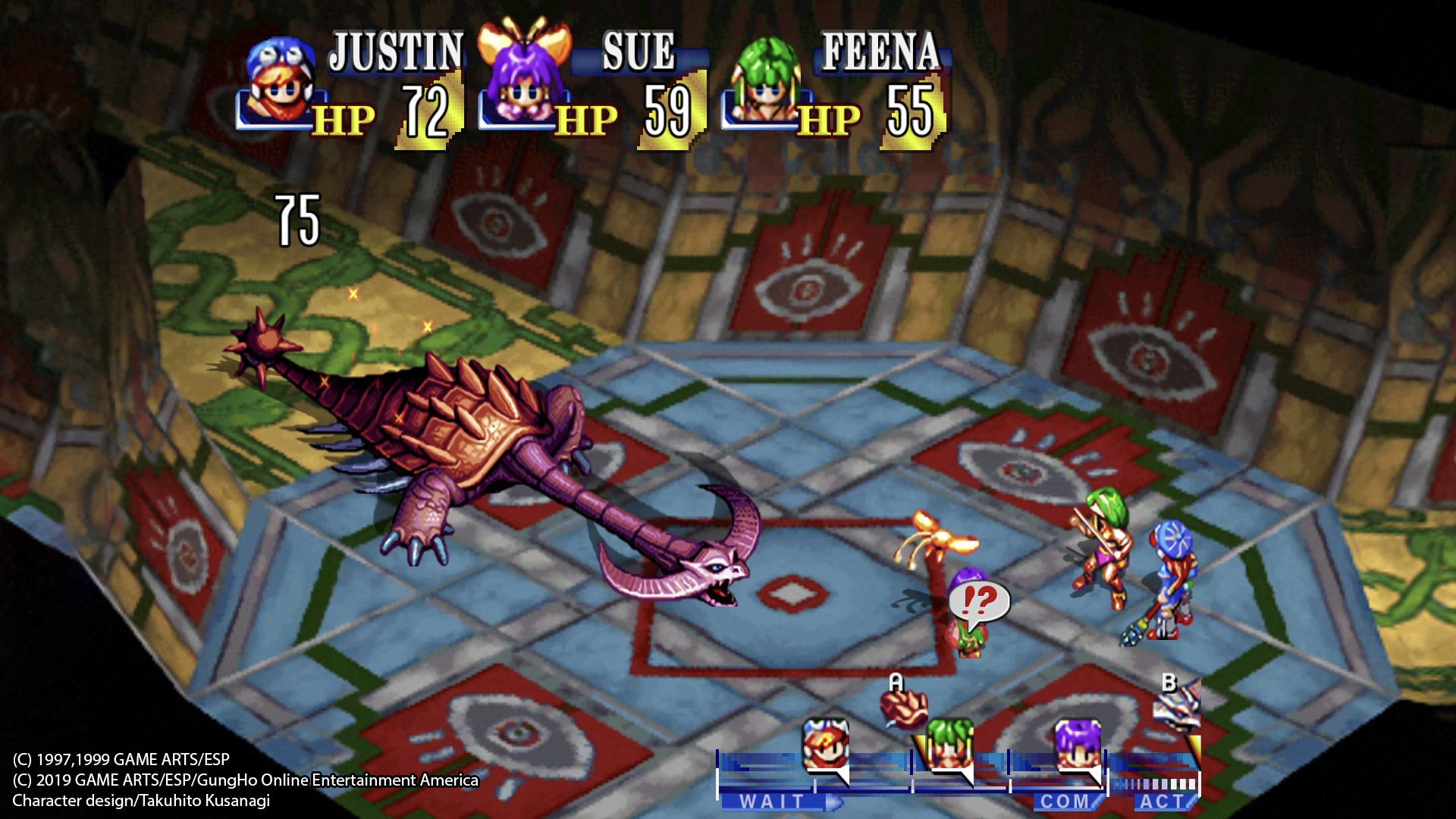
Leveling a weapon or spell level, alongside learning new spells with level conditions satisfied, gives characters a bonus stat increase, which can be a godsend given that standard experience levels (with typical JRPG experience points acquired after battle alongside money and items) rise glacially. The game mechanics work harmoniously, combat rarely dragging on aside from unskippable and overly lengthy ability and spell animations that frequently stop the action in its tracks, and other issues abound like the unclarity of if moves, be they weapon or magic-based, can cancel enemy actions (and those of certain foes, chiefly bosses, can’t be invalidated no matter what). Regardless, the battle system deserves the praise it has received then and today.
As mentioned, significant disorientation can abound when exploring dungeons, which is most common after battles. Given the dungeon design, Grandia would have seriously benefited from in-game maps, which would have singlehandedly shaved significant superfluous playtime from the game, especially for those who want to explore every corner of dungeons. Viewpoints come where the player can receive a skyward view of where they currently are but are a poor substitute. Other control issues include the inconsistent placement of save points (but these recover all health and magic), and whichever developer decided to place them after boss battles should never be allowed to work on video games ever again.
Other issues regarding the save system include the absence of autosaving when transitioning between areas and a suspend-save. Another is the parsimonious inventory limit, with players regularly needing to decide which items to dispose of and which to keep; while Stashes to place excess goods exist, the ability to send things directly to them without being at them would have been more than welcome. However, positives exist, like the remaster never crashing when I played from start to finish, the Switch Home button halting all the action and game clock, a soft reset, the ability to trade current equipment with newer gear at shops, and the always-welcome view of stat increases or decreases when shopping for new weapons and armor.
Alongside the game mechanics, the aural presentation is another high point of Grandia, beginning with a sweeping, epic central theme with numerous remixes, alongside countless other emotional pieces with superb instrumentation. However, many tracks sound unusual, like one where vocalists repeatedly shout “GUMBO!” and endless ambient themes. Lamentably, the same sordid janitorial staff-quality English voicework from the PlayStation version returns, but players can mercifully select the Japanese voices, which are a million times better. Ultimately, the aurals are good, but new rerecorded English voice acting would have been more than welcome.
One area the remaster luckily addressed, however, is the visual presentation, significantly upscaling and adjusting to widescreen the original’s graphics consisting of two-dimensional character sprites with three-dimensional scenery, which appear smooth and polished. FMVs that hybrid CG environments and anime characters also return in upscaled glory. However, there is still much environmental pixilation and blurriness, the sprites often look weird and have chibi aspects like line eyes despite their proportions, and countless character portraits look asinine and occasionally gross regarding things like Rapp picking his nose and Pakon’s nasal drippage. Still, the graphics do their job.
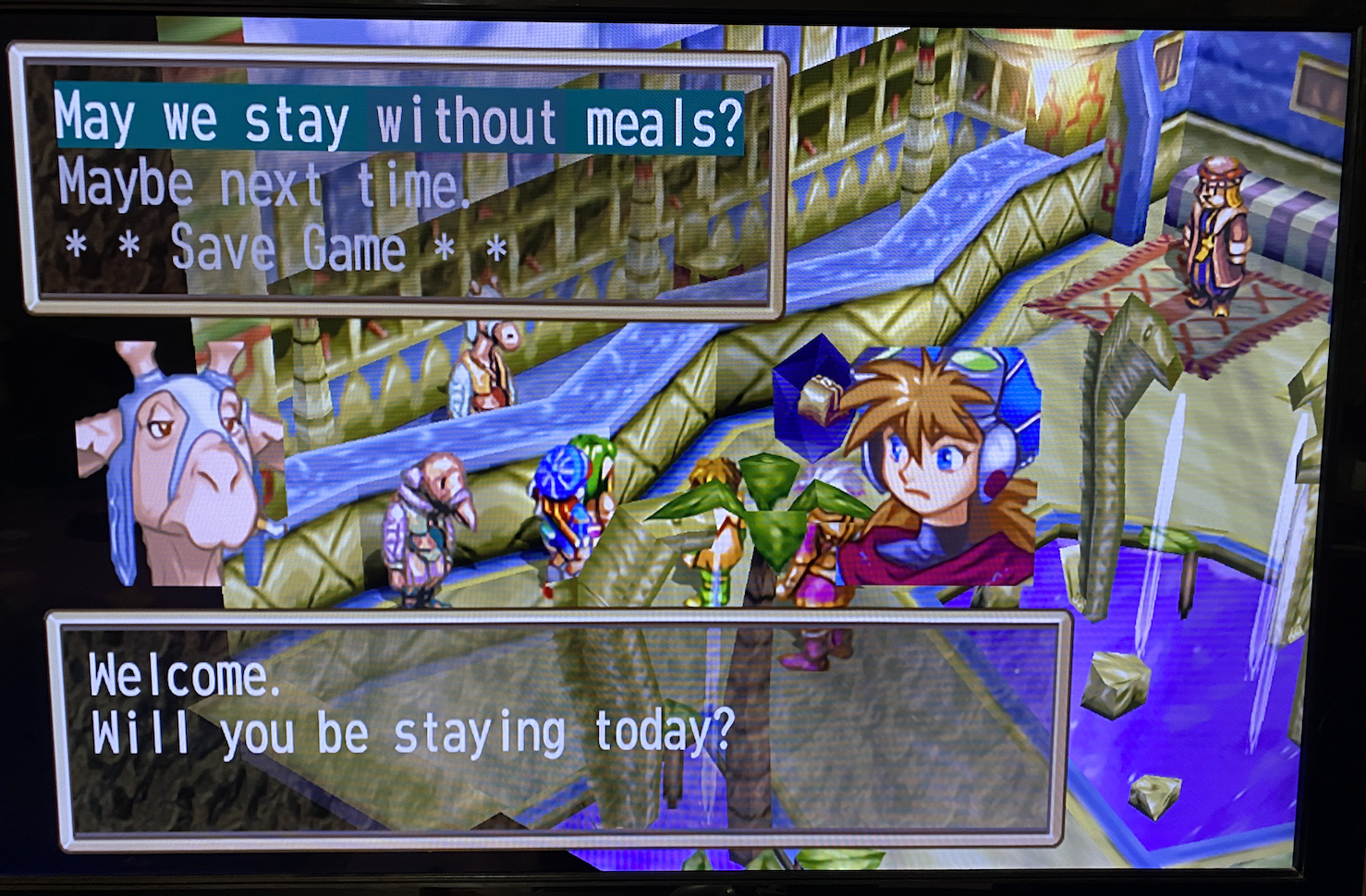
Finally, the remaster is another Japanese RPG that puts quantity well above quality, with my final playtime a little over seventy hours; however, one can blaze through it quicker if lucky. Given the overdrawn longevity, alongside the lack of lasting appeal other than three extra dungeons, maxing every element and skill level, and the frequent absence of enjoyability due to the lack of numerous basic quality-of-life features and enhancements like in-game maps and the need to reference the internet to do everything (with no New Game+, no achievements, no narrative variations, no postgame content), one playthrough will be more than enough for a lifetime for most mainstream gamers.
Overall, Grandia HD has incredible aspects like its game mechanics and soundtrack. However, it is far from the masterpiece critics and audiences have extolled it to be, given its myriad issues regarding the control, narrative, English voicework, and localization, which the remaster sadly failed to address (and even the best aspects have notable flaws). Artificial longevity is another primary issue, inexcusable given the almost strictly linear game structure, with Grandia excessively overstaying its welcome. Regardless, the “iconic” Game Arts title demonstrates that video game quality, positive or negative, is a point of view. While it is often fun, it’s hardly a bucket-list game, and mainstream gamers can easily live without experiencing it.
This review is based on a playthrough of the version included with the Grandia HD Collection to completion purchased and downloaded to the reviewer’s Nintendo Switch.
| Score Breakdown | |
|---|---|
| The Good | The Bad |
| Fun battle system. Lacks PlayStation version’s technical issues. Some decent plot beats. Great soundtrack. Remastered visuals show polish. | Requires foresight at times. Very user-unfriendly. Needs maps badly. Awful translation and English voicework. Finite lasting appeal. |
| The Bottom Line | |
| Has many positive elements but is hardly the masterpiece critics and audiences have called it. | |
| Platform | Nintendo Switch |
| Game Mechanics | 7.5/10 |
| Control | 3.5/10 |
| Story | 5.0/10 |
| Localization | 0.5/10 |
| Aurals | 8.0/10 |
| Visuals | 6.0/10 |
| Lasting Appeal | 2.5/10 |
| Difficulty | Moderate |
| Playtime | 45-90 Hours |
| Overall: 5.0/10 | |

Finally reached Chapter 3, Sir Mervyn is out of my party, and Maribel’s back in, yay. She was a Jester last I left her, and I’ll continue to have her master the classes necessary to reach Luminary before turning her into a Druid as well (she had mastered Sage before she left). Shouldn’t be too hard a task to pull off.
I’ve only made minor progress on my Grandia HD review…

Did all the stuff involving the Divine Shrine and now can use the Skystone. A cave has opened up in an excavation site, so that’s my next destination. I’m still a Hero, Ruff one as well, Sir Mervyn a Druid, and Aishe a Paladin.
No progress on my Grandia HD review today, but hopefully I should be able to do some more significant work on it tomorrow now that a major commitment has transpired.

All the islands are now in the present. Had to look at a guide to find out my next destination, the Divine Shrine, and I think I know where it is. I’m still ranking up the Hero class, Ruff is still maxed as one, Sir Mervyn is still a maxed Druid, and Aishe is still ranking up the Paladin class.
Making a little headway on my Grandia HD review…